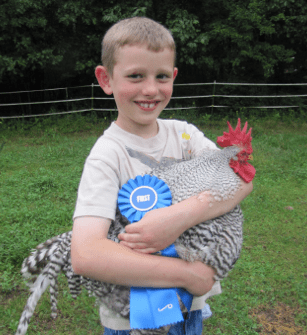Our 7-year-old son runs the egg business on our farm. We paid the startup costs – buying the chicks, converting an emu hut to a coop, and buying feed and supplies. Once the first group started laying, he took over the rest. He now buys the food, cares for the chickens and eggs, markets the eggs, and keeps records of his production, income, and expenses.

Small-scale farming is not a big money maker, and as we’ve put together our 5-year plan, we can see that we’ll have to get a bit bigger before we can realize any significant profits. However, based on just the past few months, eggs are a good place to start.
With proper care, we’re finding that our original flock of Rhode Island Reds and Araucanas (10 pullets, one cockerel total) produces an average of about 8 eggs a day. That’s about 20 dozen per month. The young flock consists of 12 Barred Rock pullets and their cockerel, and up till now, they’ve been eating and not producing. Supplemental feed for the combined flock runs him about $25/mo… less in the growing season and more in the Winter due to availability of forage. So the rough cost of production is about $1.25 per dozen.

You just can't get fresher eggs than these!
Out of that 20 dozen, our family uses about 8 a month and gives away another 2. We pay him at production cost for those. The remaining 10 dozen have sold pretty easily at $3/dozen, so combined with the ~$12 we pay him for the eggs we use, he’s been clearing a bit under $20 a month. Of this, he puts a good portion in his “giving” jar (currently he’s giving that to missions in Haiti, but he’s looking at other places for the future), and splits the rest between his “saving” and “spending” jars.
Well, this week, the Barred Rocks started dropping an egg or two, which means pretty soon our production will double. His first thought was, “that’s OK, it won’t be too hard to sell twice as many eggs.” However, we had to explain to him that although his production is doubling, the number of eggs he’ll have to sell will actually triple (because we don’t plan on upping our family consumption to 20 dozen a month!).

So, it’s on to more marketing. He’s already made a deal with the local feed store to buy his eggs, but they only pay $1.50. That’s enough to make a small profit, especially since his cost per dozen should drop significantly now that he doesn’t have so many unproductive mouths to feed, but it’s not nearly as nice as $3.
This whole process has become a supplement to our homeschool curriculum, as he’s not just learning animal science, but math, accounting, business skills, marketing, and communications also. And of course, he’s learning a lot about both personal and social responsibility, lessons that will be even more important throughout his life than the “three R’s.” Regardless of what some might say, that kind of agricultural education certainly doesn’t seem useless to us!
If he can manage to sell 30 dozen a month at the going rate, that’s about $75 a month profit. That might bump up a little if he’s successful in raising chicks this Spring. That’s too bad for a backyard business, especially if you’re a Cub Scout.
Do you raise chickens or other livestock on a small scale, and if so, do you do it for profit, as a hobby, or both? How do you market your products? I’d also love to hear other ideas for getting kids involved in business and financial planning at an early age. Thanks for stopping by, reading, and commenting!
Comments